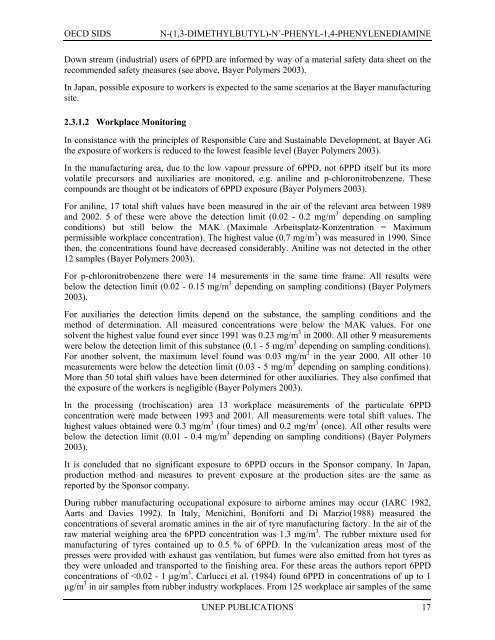N-(1,3-Dimethylbutyl)-N
N-(1,3-Dimethylbutyl)-N
N-(1,3-Dimethylbutyl)-N
You also want an ePaper? Increase the reach of your titles
YUMPU automatically turns print PDFs into web optimized ePapers that Google loves.
OECD SIDS<br />
N-(1,3-DIMETHYLBUTYL)-N´-PHENYL-1,4-PHENYLENEDIAMINE<br />
Down stream (industrial) users of 6PPD are informed by way of a material safety data sheet on the<br />
recommended safety measures (see above, Bayer Polymers 2003).<br />
In Japan, possible exposure to workers is expected to the same scenarios at the Bayer manufacturing<br />
site.<br />
2.3.1.2 Workplace Monitoring<br />
In consistance with the principles of Responsible Care and Sustainable Development, at Bayer AG<br />
the exposure of workers is reduced to the lowest feasible level (Bayer Polymers 2003).<br />
In the manufacturing area, due to the low vapour pressure of 6PPD, not 6PPD itself but its more<br />
volatile precursors and auxiliaries are monitored, e.g. aniline and p-chloronitrobenzene. These<br />
compounds are thought ot be indicators of 6PPD exposure (Bayer Polymers 2003).<br />
For aniline, 17 total shift values have been measured in the air of the relevant area between 1989<br />
and 2002. 5 of these were above the detection limit (0.02 - 0.2 mg/m 3 depending on sampling<br />
conditions) but still below the MAK (Maximale Arbeitsplatz-Konzentration = Maximum<br />
permissible workplace concentration). The highest value (0.7 mg/m 3 ) was measured in 1990. Since<br />
then, the concentrations found have decreased considerably. Aniline was not detected in the other<br />
12 samples (Bayer Polymers 2003).<br />
For p-chloronitrobenzene there were 14 mesurements in the same time frame. All results were<br />
below the detection limit (0.02 - 0.15 mg/m 3 depending on sampling conditions) (Bayer Polymers<br />
2003).<br />
For auxiliaries the detection limits depend on the substance, the sampling conditions and the<br />
method of determination. All measured concentrations were below the MAK values. For one<br />
solvent the highest value found ever since 1991 was 0.23 mg/m 3 in 2000. All other 9 measurements<br />
were below the detection limit of this substance (0.1 - 5 mg/m 3 depending on sampling conditions).<br />
For another solvent, the maximum level found was 0.03 mg/m 3 in the year 2000. All other 10<br />
measurements were below the detection limit (0.03 - 5 mg/m 3 depending on sampling conditions).<br />
More than 50 total shift values have been determined for other auxiliaries. They also confimed that<br />
the exposure of the workers is negligible (Bayer Polymers 2003).<br />
In the processing (trochiscation) area 13 workplace measurements of the particulate 6PPD<br />
concentration were made between 1993 and 2001. All measurements were total shift values. The<br />
highest values obtained were 0.3 mg/m 3 (four times) and 0.2 mg/m 3 (once). All other results were<br />
below the detection limit (0.01 - 0.4 mg/m 3 depending on sampling conditions) (Bayer Polymers<br />
2003).<br />
It is concluded that no significant exposure to 6PPD occurs in the Sponsor company. In Japan,<br />
production method and measures to prevent exposure at the production sites are the same as<br />
reported by the Sponsor company.<br />
During rubber manufacturing occupational exposure to airborne amines may occur (IARC 1982,<br />
Aarts and Davies 1992). In Italy, Menichini, Boniforti and Di Marzio(1988) measured the<br />
concentrations of several aromatic amines in the air of tyre manufacturing factory. In the air of the<br />
raw material weighing area the 6PPD concentration was 1.3 mg/m 3 . The rubber mixture used for<br />
manufacturing of tyres contained up to 0.5 % of 6PPD. In the vulcanization areas most of the<br />
presses were provided with exhaust gas ventilation, but fumes were also emitted from hot tyres as<br />
they were unloaded and transported to the finishing area. For these areas the authors report 6PPD<br />
concentrations of
















